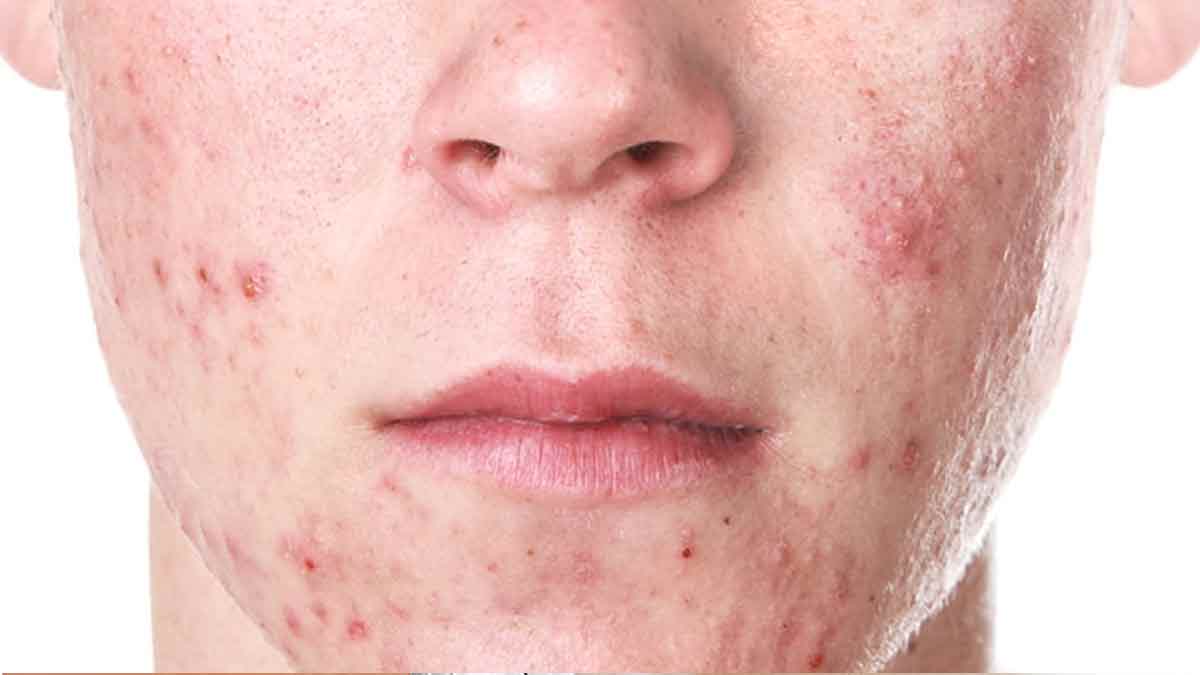Hormonal acne can impact men’s skin health and self-esteem. Acne, often associated with adolescence, can persist into adulthood, causing distress and frustration. Understanding the science behind hormonal acne and the effective strategies to combat it can help men regain control over their skin health.
The Science Behind Hormonal Acne
Hormonal acne in men, or male hormonal acne, is often linked to fluctuations in testosterone levels. Testosterone, an androgen hormone, plays a significant role in sebum production. Sebum is an oily substance that, when overproduced, can clog pores and lead to acne.
More from Glowing Gorgeous: Find out here the Best Silicone-Free Moisturizers And Why Do You Care
Role of Testosterone in Acne Development
Testosterone stimulates sebum production, and an excess of this hormone can lead to overactive sebaceous glands. When these glands produce too much sebum, it can block pores, trapping dead skin cells, dirt, and bacteria. This blockage can cause inflammation and result in acne. It’s important to note that while testosterone is often associated with men, both men and women produce this hormone. However, men tend to have higher levels of testosterone, which can make them more prone to hormonal acne.
How Hormonal Breakouts Occur
Hormonal breakouts typically occur when there’s a spike in testosterone levels. This can be due to various factors, including stress, exercise, sexual activity, and even age. Additionally, individuals with a higher density of testosterone receptors in their skin are more prone to hormonal acne, even if their testosterone levels are within the normal range. This is because these receptors can bind to testosterone, triggering an increase in sebum production and leading to acne.
Identifying Hormonal Acne in Men
Hormonal acne is characterized by inflamed, tender bumps or large, pus-filled pimples. These are often deeper than superficial whiteheads or blackheads and are commonly found on the lower half of the face, including the cheeks, jawline, and chin. Men may also experience hormonal acne on their chest, shoulders, and back due to a higher density of sebaceous glands in these areas.
Causes of Hormonal Acne in Men
Several factors can contribute to the development of hormonal acne in men. These include lifestyle factors, such as diet and stress, as well as genetic predispositions.
The Influence of Lifestyle Factors
Certain lifestyle factors can influence testosterone levels and, consequently, sebum production. For instance, stress can cause a spike in testosterone, leading to increased sebum production and potential acne breakouts. Similarly, intense exercise can also cause a temporary increase in testosterone levels. Furthermore, diet can also play a role in hormonal acne. Consuming a diet high in refined carbohydrates and sugars can cause spikes in insulin, another hormone that can stimulate sebum production.
Genetic Factors and Hormonal Acne
Genetics also play a role in the development of hormonal acne. Men whose parents had acne are more likely to experience it themselves. This is because they may have a higher density of testosterone receptors in their skin, making them more sensitive to the hormone. Additionally, certain genetic conditions, such as polycystic ovary syndrome (PCOS), can cause hormonal imbalances that lead to acne.
Effective Strategies to Combat Hormonal Acne
There are several strategies men can employ to combat hormonal acne. These include lifestyle modifications, a targeted skincare regimen, and medical treatments.
Lifestyle Modifications
Making certain lifestyle changes can help manage hormonal acne. This includes maintaining a healthy diet, managing stress, and getting adequate sleep. Regular exercise can also help, but it’s important to cleanse the skin thoroughly after workouts to prevent sweat and oil from clogging the pores. Additionally, avoiding certain foods that can trigger acne, such as dairy and high-glycemic foods, can also be beneficial.
Skincare Regimen for Hormonal Acne
A targeted skincare regimen is crucial for managing hormonal acne. This should include a gentle cleanser to remove excess oil and dirt, a non-comedogenic moisturizer to hydrate the skin without clogging pores, and a treatment product containing ingredients like benzoyl peroxide or salicylic acid to combat acne-causing bacteria and unclog pores. It’s also important to exfoliate the skin regularly to remove dead skin cells that can clog pores. However, it’s crucial to not over-exfoliate as this can irritate the skin and exacerbate acne.
Medical Treatments and Therapies
In some cases, over-the-counter products may not be enough to manage hormonal acne. In these instances, it may be necessary to consult with a dermatologist who can prescribe stronger treatments. These may include topical retinoids, oral antibiotics, or even hormonal therapies. Topical retinoids, such as tretinoin, can help unclog pores and reduce the appearance of acne. Oral antibiotics can help reduce the bacteria that contribute to acne. Hormonal therapies, such as spironolactone, can help balance hormone levels and reduce the occurrence of hormonal acne.
More from Glowing Gorgeous: Find out here Hyram’s Recommended Face Sunscreens For The Summer
Product Recommendations
La Roche-Posay Effaclar Medicated Gel Acne Cleanser
This medicated acne cleanser from La Roche-Posay, a trusted name in premium skincare, is a powerhouse when it comes to combating acne. It contains 2% salicylic acid, a potent ingredient known for its ability to unclog pores and reduce inflammation. It’s gentle enough for daily use and can also be used on the body to treat and prevent breakouts on the chest, shoulders, and back.
Neutrogena On-The-Spot Acne Spot Treatment
For those stubborn pimples that need a little extra attention, this spot treatment from Neutrogena is a lifesaver. It contains 2.5% benzoyl peroxide to target acne-causing bacteria and prevent new blemishes from forming.
Obagi Medical CLENZIderm M.D. Therapeutic Moisturizer
Hydration is key when it comes to maintaining healthy skin, and this therapeutic moisturizer from Obagi Medical delivers just that. It’s designed to comfort and hydrate the skin, making it perfect for those using acne treatments that can often cause dryness and irritation.
PCA SKIN Intensive Clarity Treatment
This intensive treatment from PCA SKIN, a leader in luxury skincare, is perfect for those looking to take their acne treatment to the next level. It contains retinol, a powerful ingredient known for its ability to reduce the appearance of acne and improve skin texture.
EltaMD UV Clear Facial Sunscreen Broad-Spectrum SPF 46
Sun protection is key when it comes to maintaining healthy skin, and this sunscreen from EltaMD delivers just that. It’s oil-free, making it perfect for acne-prone skin, and contains niacinamide, a powerful ingredient known for its ability to reduce inflammation and improve the appearance of acne.
Paula’s Choice SKIN PERFECTING 2% BHA Liquid Salicylic Acid Exfoliant
Exfoliation is a crucial step in any skincare regimen, and this liquid exfoliant from Paula’s Choice makes it easy. It contains 2% salicylic acid to gently exfoliate the skin, unclog pores, and reduce the appearance of acne.
Preventing Hormonal Acne
Prevention is always better than cure, and that’s certainly true when it comes to hormonal acne. By maintaining a consistent skincare regimen, making necessary lifestyle modifications, and seeking medical treatment when necessary, it’s possible to keep hormonal acne at bay.
Conclusion
Hormonal acne in men can be a challenging condition to manage, but with the right knowledge and tools, it’s entirely possible to regain control over your skin health. Remember, everyone’s skin is different, so what works for one person may not work for another. It’s important to listen to your skin and adjust your skincare regimen as necessary.
FAQs
Do men get hormonal acne?
Yes, men can and do get hormonal acne. It’s often linked to fluctuations in testosterone levels, which can stimulate excess sebum production and lead to acne.
How to reduce hormonal acne in men?
Reducing hormonal acne in men involves a combination of lifestyle modifications, a targeted skincare regimen, and potentially medical treatments. This can include maintaining a healthy diet, managing stress, using acne-fighting skincare products, and consulting with a dermatologist.
How to get rid of hormonal acne in men?
Getting rid of hormonal acne in men involves a similar approach to reducing it. It’s important to cleanse the skin thoroughly, use non-comedogenic products, and treat active breakouts with effective ingredients like benzoyl peroxide or salicylic acid.
Can men get hormonal acne in their 20s?
Yes, men can get hormonal acne in their 20s and even beyond. While hormonal acne is often associated with adolescence, it can persist into adulthood due to factors like stress, diet, and genetic predisposition.


 La Roche-Posay Effaclar Medicated Gel Facial Cleanser, Foaming Acne Face Wash...
La Roche-Posay Effaclar Medicated Gel Facial Cleanser, Foaming Acne Face Wash... Neutrogena On-The-Spot Acne Spot Treatment with 2.5% Benzoyl Peroxide Acne...
Neutrogena On-The-Spot Acne Spot Treatment with 2.5% Benzoyl Peroxide Acne... Obagi Medical CLENZIderm M.D. Therapeutic Moisturizer Glycerin 20% Skin...
Obagi Medical CLENZIderm M.D. Therapeutic Moisturizer Glycerin 20% Skin... PCA SKIN Intensive Clarity Treatment - 0.5% Pure Vitamin A Retinol & 2%...
PCA SKIN Intensive Clarity Treatment - 0.5% Pure Vitamin A Retinol & 2%... EltaMD UV Clear Face Sunscreen, SPF 46 Oil Free Sunscreen with Zinc Oxide,...
EltaMD UV Clear Face Sunscreen, SPF 46 Oil Free Sunscreen with Zinc Oxide,... Paula's Choice Skin Perfecting 2% BHA Liquid Salicylic Acid Exfoliant, Gentle...
Paula's Choice Skin Perfecting 2% BHA Liquid Salicylic Acid Exfoliant, Gentle...
Comments